Unit on Ableism - Campus Activism
Unit on Ableism - Campus Activism
Unit on Ableism - Campus Activism
- No tags were found...
Create successful ePaper yourself
Turn your PDF publications into a flip-book with our unique Google optimized e-Paper software.
http://www.socialjusticeeducati<strong>on</strong>.orgTools for Building Justice, January, 2003<str<strong>on</strong>g>Unit</str<strong>on</strong>g> <strong>on</strong> <strong>Ableism</strong><str<strong>on</strong>g>Unit</str<strong>on</strong>g> OutlineSessi<strong>on</strong> #1. Introducti<strong>on</strong> and photosStudents explore the c<strong>on</strong>cepts of “ability” and “disability,” and review stereotypes of “normal”and “abnormal” in classifying human appearance and behavior. Sessi<strong>on</strong> closes with a structureddiscussi<strong>on</strong> of photos depicting mistreatment of people with disabilities.2. DisabilityBeginning with a list of what counts as disability, students explore early experiences both ofhaving a disability and of encountering some<strong>on</strong>e with a visible disability. Sessi<strong>on</strong> closes withreflecti<strong>on</strong> <strong>on</strong> how early experiences reflect their pictures of disability and people withdisabilities.3. <strong>Ableism</strong>Students address ableism as an oppressi<strong>on</strong>, examining stereotypes, violence and instituti<strong>on</strong>alizedmistreatment people with disabilities experience, as well as the effects of these forms ofoppressi<strong>on</strong> <strong>on</strong> them.4. Fighting for AccessStudents review c<strong>on</strong>cepts of resistance and develop a plan for improving access in the classroomfor people with different types of disability.5. Organizing/Acti<strong>on</strong><str<strong>on</strong>g>Unit</str<strong>on</strong>g> <strong>on</strong> <strong>Ableism</strong>1
Sessi<strong>on</strong> 1. Introducti<strong>on</strong>Aims• To introduce the unit <strong>on</strong> ableism• To examine the c<strong>on</strong>cepts of ability and disability• To identify and discuss two c<strong>on</strong>flicts involving ableismSkillsStudents will:• Identify some normal experiences of living with human limitati<strong>on</strong>s• Identify stigmatizati<strong>on</strong> of some kinds of physical, mental and emoti<strong>on</strong>al limits as disabilities• Identify target and n<strong>on</strong>target group members in three c<strong>on</strong>flicts involving ableism• Suggest “resistance and alliance” resp<strong>on</strong>ses to c<strong>on</strong>flictsPreparati<strong>on</strong>You will need photos for discussi<strong>on</strong> and list of agreements from prior sessi<strong>on</strong>s. Use a markerboard, butcher or easel paper for the “3 hearts” exercise, for use in later sessi<strong>on</strong>s.Sessi<strong>on</strong> Descripti<strong>on</strong>Students explore the c<strong>on</strong>cepts of “ability” and “disability,” and review stereotypes of “normal”and “abnormal” in classifying human appearance and behavior. Sessi<strong>on</strong> closes with a structureddiscussi<strong>on</strong> of photos depicting mistreatment of people with disabilities.Sessi<strong>on</strong> Outline1. To Begin 5 minutes2. Ability 15 minutes3. Picturing Disability 15 minutes4. Photos 15 minutes5. C<strong>on</strong>clusi<strong>on</strong> 5 minutesAgenda1. To Begin 5 minutesRemind students of agreements. Explain that this unit addresses “ableism”: the discriminati<strong>on</strong>against and mistreatment of people who live with disabilities.2. Ability 15 minutesC<strong>on</strong>duct the following visualizati<strong>on</strong>, having students sit comfortably in their chairs, close theireyes or look at the floor, and take a few moments in silence to notice their breathing. Give thefollowing directi<strong>on</strong>s:a. Pick a favorite animal other than human beings⎯mammal, fish, bird, reptile, etc. Visualizeit⎯make an image before your mindb. Visualize your animal as it lives in the world: how it lives, how it functi<strong>on</strong>s, how it movesthrough the world.<str<strong>on</strong>g>Unit</str<strong>on</strong>g> <strong>on</strong> <strong>Ableism</strong>2
c. Now think of something that your animal does⎯an ability it has⎯that human beings,including you, d<strong>on</strong>’t have. (E.g., if you are picturing a bird that can fly, flying is <strong>on</strong>e thing it doesthat you can’t do without help. If you are picturing a fish with gills, it can live and breathe underwater, whereas you would need assistance.) Make a clear picture for yourself of this ability thatyou lack. Now think of the following questi<strong>on</strong>s silently:• Would you have noticed, without this visualizati<strong>on</strong>, that you “lacked” an ability?• How is your life impacted by being without this ability?• How do you get al<strong>on</strong>g without this ability?• How do you compensate for lacking this ability? E.g. if the ability is flying, what do youdo to be able to fly?• Do you feel that you are “less than” a regular organism because you “lack” this ability?Close the visualizati<strong>on</strong>. Have students break into dyads to take turns following the instructi<strong>on</strong>:• Tell your partner the “ability” you d<strong>on</strong>’t have; then identify what abilities you have thatenable you to get al<strong>on</strong>g without this particular ability; e.g., if the ability you d<strong>on</strong>’t have isthe ability to fly, you get al<strong>on</strong>g without it by all the other forms of movement andtransportati<strong>on</strong> you have.Close the dyad by having a few students report how it felt to do the visualizati<strong>on</strong>, and/or whatthey came up with in the dyad.Summarize by pointing out that:• As human beings, it is normal for us to be able to do some kinds of things and not doothers.• Mostly, we do not experience the things we can’t do as a lack or something thatdiminishes us. In fact, we may not even notice these “limits.”• For all kinds of these limits, we figure out, living normal lives, how to get around them,how to compensate.3. Picturing Disability 15 minutesWrite the word “disability” <strong>on</strong> the board. Ask students, for a few moments, to throw out words orphrases they attach to the word “disability.”Explain that students have been talking about our “abilities,” the ways we functi<strong>on</strong> in the world.It is part of every human life to have some abilities⎯be able to do some things⎯and not doothers. And our “abilities” are always changing as we grow and grow older.Explain that you are now turning to look at a different picture of ability: how society pictures“normal” and “abnormal” in physical, emoti<strong>on</strong>al and mental human capacity and behavior⎯howit pictures disability.Remind students of heart exercise⎯we are all “hearts.” At different times in a heart’s life,sometimes throughout her/his life, they may experience limits in physical, mental, or emoti<strong>on</strong>alcapacity to do something.<str<strong>on</strong>g>Unit</str<strong>on</strong>g> <strong>on</strong> <strong>Ableism</strong>3
• What does a heart do when it experiences a limit? (Ans: it changes, figures out a way toadapt, &c.)• Is a heart that experiences any of these limits “less than” a heart?Explain that “ableism”⎯the mistreatment of people identified as having particular kinds of“limits”⎯ begins to happen when we use stereotypes of what is supposed to be “normal” forhuman beings and what is “abnormal.”Draw three hearts <strong>on</strong> marker-board or butcher paper you can use later, labeled “mental,”“emoti<strong>on</strong>al,” and “physical.”mentalemoti<strong>on</strong>al.physicalExplain that each of these is a picture of part of what it means to be human: what it’s like for ahuman to think; to have emoti<strong>on</strong>s; and to be a body.Draw boxes that enclose each of the hearts. Explain that each box stands for the “shaping” thathappens to hearts—the way social instituti<strong>on</strong>s train all of us in what is “normal” and what isn’tnormal. (If you have d<strong>on</strong>e the unit <strong>on</strong> sexism, you may refer to the act like a man/act like a ladyboxes as expectati<strong>on</strong>s placed up<strong>on</strong> young people about how young men and women are eachsupposed to act.)For the following, ask the questi<strong>on</strong> and write student resp<strong>on</strong>ses for each of the boxed hearts.Ask:a) What are words we use to describe a pers<strong>on</strong> with a “normal” mind or mental state?What are words we use to describe a pers<strong>on</strong> with “normal” feelings?What are words we use to describe a pers<strong>on</strong> with a “normal” physical body?Write these words into the appropriate box/heart.<str<strong>on</strong>g>Unit</str<strong>on</strong>g> <strong>on</strong> <strong>Ableism</strong>4
) What are words we use to describe an “abnormal” mind or mental state?What are words we use to describe “abnormal” feelings of a pers<strong>on</strong>?What are words we use to describe “abnormal” features of a body?Write these words around the exterior of the appropriate box/heart. Draw a circle around thewhole.c) What are the names we sometimes call/stereotypes we use for people identified as having“abnormal” minds?People identified as having “abnormal feelings”?People identified as having “abnormal” bodies?Write these words around the exterior of the appropriate circle.Close the exercise by having students reflect <strong>on</strong> the words <strong>on</strong> the board. Ask them, recognizingthe stereotypes <strong>on</strong> the board, to define or give examples for what “ableism” is⎯discriminati<strong>on</strong>against people with identified disabilities.4. Photos 15 minutesDistribute the photographs in turn, c<strong>on</strong>ducting the following discussi<strong>on</strong>:Incident #32 “Get Out of My Way” (Female in motorized wheelchair in aisle in supermarket;women behind her trying to get her food cart past)(uncapti<strong>on</strong>ed)• What’s happening in this scene?• What do you think the standing woman is saying to herself?(with capti<strong>on</strong>s)• What’s happening in this scene?• What is the standing woman thinking?• Based up<strong>on</strong> our previous discussi<strong>on</strong>, what stereotypes might she have in her mind about thewoman in the chair?• What might happen next⎯what might the standing woman do?• How might her acti<strong>on</strong>s affect the woman in the chair?• Who is being inc<strong>on</strong>venienced in this scene? (Ans.: both women)• Who is resp<strong>on</strong>sible for the seated woman’s inc<strong>on</strong>venience?• When you look at the way the supermarket is built, its aisle length, products’ display, etc.,whom is the market set up for⎯who is its ideal customer? Who is it not set up for? How canyou tell?• If you were a best friend of the woman in the chair, what would you do in this scene?Incident #33. "Go Out With Me?" (Young man <strong>on</strong> crutches asking young woman for date)(uncapti<strong>on</strong>ed)• What’s happening in this scene?<str<strong>on</strong>g>Unit</str<strong>on</strong>g> <strong>on</strong> <strong>Ableism</strong>5
• Describe the expressi<strong>on</strong>s <strong>on</strong> the faces of the student <strong>on</strong> the left and the three observingstudents in the background. What do they suggest about what is happening?(with capti<strong>on</strong>s)• What’s happening in this scene?• How does the young woman seem to feel about being asked out by the young man, based <strong>on</strong>the expressi<strong>on</strong> <strong>on</strong> her face?• How do the spectators seem to feel about what’s happening?• How is the young woman likely to reply to the young man?• If she turns him down, what might be the real reas<strong>on</strong>s she does so, whether she disclosesthem or not?• Do these reas<strong>on</strong>s have to do with the young man as a pers<strong>on</strong>, or with his disability?• When the young woman and the spectators look at the young man, what do they see: thepers<strong>on</strong>, or his disability?• Is some<strong>on</strong>e being targeted in this scene? If so, who? What mistreatment is happening?• If the young man is turned down, how might he react in a way that would be sexist(mistreating women)?• How could he handle being turned down without being sexist?• How could he resist mistreatment?• If the young woman or the spectators were acting as allies to the young man, what mighteach of them do?• If the young woman wanted to be an ally to the young man, but also didn’t want to go outwith him (e.g., she wants to be friends, but isn’t romantically interested in him), how couldshe handle the scene?[photo <strong>on</strong> mental health oppressi<strong>on</strong> not d<strong>on</strong>e yet]5. C<strong>on</strong>clusi<strong>on</strong> 5 minutesAsk students to volunteer reflecti<strong>on</strong>s⎯what they noticed, thought about or learned in thissessi<strong>on</strong>.<str<strong>on</strong>g>Unit</str<strong>on</strong>g> <strong>on</strong> <strong>Ableism</strong>6
Sessi<strong>on</strong> 2 DisabilityAims• To explore early, negative experiences of having disabilities• To explore early experiences of encountering some<strong>on</strong>e with a visible disability, includingmessages about who disabled people areSkillsStudents will:• Define physical, emoti<strong>on</strong>al and/or physical states identified as disabilities• Understand the distincti<strong>on</strong> between having a limitati<strong>on</strong> and social stigmatizati<strong>on</strong> of disability• Identify early experiences of limitati<strong>on</strong> and stigmatizati<strong>on</strong>• Identify messages they received from early experiences of witnessing others’ disabilitiesPreparati<strong>on</strong>Post the “3 hearts” exercise from the last sessi<strong>on</strong>. You will a marker board or butcher paper tocreate the word map of “disability” to be able to refer to it in the next sessi<strong>on</strong>.Sessi<strong>on</strong> Descripti<strong>on</strong>Beginning with a list of what counts as disability, students explore early experiences both ofhaving a disability and of encountering some<strong>on</strong>e with a visible disability. Sessi<strong>on</strong> closes withreflecti<strong>on</strong> <strong>on</strong> how early experiences reflect their pictures of disability and people withdisabilities.Sessi<strong>on</strong> Outline1. To Begin 5 minutes2. What is disability? 10 minutes3. Early experiences 30 minutes4. C<strong>on</strong>clusi<strong>on</strong> 10 minutesAgenda1. To Begin 5 minutesReview last sessi<strong>on</strong>. Explain that today the class will look at disability itself⎯the different thingsthat count as “disabilities” in our society, as well as early experiences students may have ofbeing disabled and of witnessing other people with disabilities.2. What is disability? 10 minutesWrite the word “disability” <strong>on</strong> marker-board or butcher paper. Referring to the three “hearts”from the last sessi<strong>on</strong>⎯physical, emoti<strong>on</strong>al, and mental⎯ask students to c<strong>on</strong>struct a word map ofthe kinds of physical, mental and emoti<strong>on</strong>al states or c<strong>on</strong>diti<strong>on</strong>s that count as “disabilities.”Invite them to think as widely as they can of anything that counts as the experience of a limit in“normal” human functi<strong>on</strong>ing.As a special instructi<strong>on</strong>, have them make the list as much as possible without using stereotypicalwords or medical terms, in order to keep the terms or phrases as close as possible to how those ofus with identified disabilities might use terms ourselves. (Sometimes, of course, there will be no<str<strong>on</strong>g>Unit</str<strong>on</strong>g> <strong>on</strong> <strong>Ableism</strong>7
other terms to use: "blind," “dyslexia,” and “paraplegic” are medical terms in comm<strong>on</strong> usage.)Make the following distincti<strong>on</strong>s, to ensure the terms include:• Physical, mental and emoti<strong>on</strong>al disabilities• Short-term or temporary and l<strong>on</strong>g-term c<strong>on</strong>diti<strong>on</strong>s• Disabilities related to illness or injury and those not related to illness or injury• Visible and invisible, “hidden” disabilities• Learning disabilities• Less involved (“milder”), such as allergies, skin c<strong>on</strong>diti<strong>on</strong>s, and so forth, and moreinvolved (“more severe”), such as mobility impairment, blindness, deafness and so forth• C<strong>on</strong>diti<strong>on</strong>s that may seem to be voluntarily c<strong>on</strong>tracted by people, like addicti<strong>on</strong>s such asalcoholismAt the close of the exercise, invite students to look over the list. Have them silently identifydisabilities, listed or not, that they may have experienced, and/or that family members or friendshave experienced. Ask:• Why is it important to try to describe disabilities without using stereotypical words ormedical terms? (Ans: sometimes stereotypes or medical terms devalue or put down whatthey name; some medical terms are developed by physicians for their own use, not bydisabled people themselves; medical terms may not be familiar to disable people, oradequately name their own experience of their disability, &c.)3. Early experiences 30 minutesExplain that the class will now be looking at two kinds of early experiences young people mayhave: of having identified disabilities and of witnessing other people with identified disabilities.Have students form dyads with others they may not know so well; then have dyads join into 4-member groups.a. Being disabledUsing the list <strong>on</strong> the board, have students identify silently an early experience they havepers<strong>on</strong>ally had of having a disability⎯an injury, illness, or more l<strong>on</strong>g-term c<strong>on</strong>diti<strong>on</strong>, with littleinvolvement or a lot of involvement. It will likely be a disability identified by others, e.g.diagnosed by a doctor, but it doesn’t have to be. It could be as little involved as having a brokenleg, or being identified as needing glasses or “corrective” lens, or getting sick.Have students take turns in their group, 2-3 minutes each, talking about what they can rememberabout being disabled in this way. They do not have to identify the disability, but can simply talkabout their experience. Remind students of the right to pass, and remind them of thec<strong>on</strong>fidentiality agreement, to keep what other students in their group say c<strong>on</strong>fidential, and not tocomment <strong>on</strong> what others say when it is their own turn to speak. Post the following questi<strong>on</strong>s forstudents to speak to if they wish:• What was it like to have this c<strong>on</strong>diti<strong>on</strong>?• What “limits” did I experience with this c<strong>on</strong>diti<strong>on</strong>?• How did I find out that I had this c<strong>on</strong>diti<strong>on</strong>?• If it was “diagnosed” by a doctor or clinician or other professi<strong>on</strong>al adult, how did it feelto be “diagnosed”?• How did I feel about having this c<strong>on</strong>diti<strong>on</strong>?<str<strong>on</strong>g>Unit</str<strong>on</strong>g> <strong>on</strong> <strong>Ableism</strong>8
• How did other people act around me when/if they knew about the c<strong>on</strong>diti<strong>on</strong>?• How did their acti<strong>on</strong>s, if any, make me feel about myself?• How does it feel to talk about this with other students?At the close of the discussi<strong>on</strong>, rec<strong>on</strong>vene class for a moment to ask for a show of hands: howmany students experienced some discomfort in talking about their experiences. Ask a few tovolunteer thoughts <strong>on</strong> why they might be feeling discomfort: what is it about being identified ashaving a disability that may makes some<strong>on</strong>e uncomfortable? Have students write for 2-3 minutesabout any feelings they had during this activity.b. Witnessing disabilityRec<strong>on</strong>vene groups for the next round, following the same format and instructi<strong>on</strong>s, to address thefollowing questi<strong>on</strong>. Have students identify silently an early experience of witnessing or beingshown some<strong>on</strong>e with a visible disability. Invite them to think of the earliest experience, or the<strong>on</strong>e that comes immediately to mind. Then have them take turns as before, using the followingposted questi<strong>on</strong>s if they wish:• Briefly describe the experience of witnessing, or having some<strong>on</strong>e else show them, apers<strong>on</strong> with a disability.• How did it feel, witnessing this pers<strong>on</strong>?• How did other people act around this pers<strong>on</strong>?• Think of any ways the pers<strong>on</strong> with a disability was treated as “different,” and how thatmade you feel.• If another pers<strong>on</strong> was with you, how did this pers<strong>on</strong> react? How might they have told youto act?• If you were told to act in a certain way, how did that make you feel? How might it havemade you feel about having a disability?• When you think about it now, what informati<strong>on</strong> about that pers<strong>on</strong> or their experiencewould you have liked to have had? If no <strong>on</strong>e gave you informati<strong>on</strong> then, why do youthink that was?• If you had been able to ask any questi<strong>on</strong> you wanted to of the pers<strong>on</strong> with a disability,what would you have wanted to ask?• Finally, describe any way that you can think of that this experience might have gotten inyour way of having a normal human relati<strong>on</strong>ship with the pers<strong>on</strong> with a disability.4. C<strong>on</strong>clusi<strong>on</strong> 10 minutesRec<strong>on</strong>vene class for closing reflecti<strong>on</strong>, addressing the questi<strong>on</strong>:• What do my early experiences show about how I was to picture disability and peoplewith disabilities?After a few resp<strong>on</strong>ses, have students report, without discussing what other students in theirgroups said, what insights they may have from their small-group discussi<strong>on</strong>s. If time remains (orfor homework), have students write for several minutes about this sessi<strong>on</strong>.<str<strong>on</strong>g>Unit</str<strong>on</strong>g> <strong>on</strong> <strong>Ableism</strong>9
Sessi<strong>on</strong> 3 <strong>Ableism</strong>Aims• To define ableism• To examine three aspects of the oppressi<strong>on</strong> of ableismSkillsStudents will:• Identify target and n<strong>on</strong>target groups of mental, physical and emoti<strong>on</strong>al ableism• Produce examples of stereotypes, violence, and instituti<strong>on</strong>al mistreatment that differentgroups of people with disabilities experience.Preparati<strong>on</strong>You will need a copy of the power chart from the foundati<strong>on</strong> sessi<strong>on</strong>s for reference, as well asthe 3-hearts exercise from sessi<strong>on</strong> 1 and the disability word map from sessi<strong>on</strong> 2.Sessi<strong>on</strong> Descripti<strong>on</strong>Students address ableism as an oppressi<strong>on</strong>, examining stereotypes, violence and instituti<strong>on</strong>alizedmistreatment people with disabilities experience, as well as the effects of these forms ofoppressi<strong>on</strong> <strong>on</strong> them.Sessi<strong>on</strong> Outline1. To Begin 10 minutes2. <strong>Ableism</strong> 15 minutes3. 3 faces of ableism 20 minutes4. Closure 10 minutesAgenda1. To Begin 10 minutesWrite the phrases “physically different,” “mentally different,” and “emoti<strong>on</strong>ally different” <strong>on</strong> theboard. For each phrase, ask students to call out words used to describe the kinds ofphysical/emoti<strong>on</strong>al/mental differences⎯differences in body size and shape, mental intelligence,emoti<strong>on</strong>al intelligence, sense-percepti<strong>on</strong>s, speech, behavior and so forth⎯that people can have.Reminding students of the 3-heart-box exercise from sessi<strong>on</strong> 1, encourage students to avoidstereotypical names, using neutral words as much as possible⎯words that d<strong>on</strong>’t reflect negativejudgments or putdowns about the difference in questi<strong>on</strong>.Write the word “disabled” <strong>on</strong> the board. Ask students what happens to our image of“differences” when particular differences are renamed “disabilities.”Ask what is implied when some<strong>on</strong>e is described as dis-abled. Ask students for words that havebeen used in our society to mean “disabled,” and write these <strong>on</strong> the board. Be sure to include“handicapped” and “impaired.” What message is implied in these terms?Finally, write the phrases “disabled people” and “people with disabilities” <strong>on</strong> the board. Askstudents to notice any differences in emphasis in these two phrases. Close by explaining that<str<strong>on</strong>g>Unit</str<strong>on</strong>g> <strong>on</strong> <strong>Ableism</strong>10
from now <strong>on</strong> you will be encouraging them to use the latter phrase, to prioritize the pers<strong>on</strong> ratherthan the disability.2. <strong>Ableism</strong> 15 minutesInvite students, following the “try it <strong>on</strong>” agreement, to c<strong>on</strong>sider the following definiti<strong>on</strong>. Explainthe term “ableism,” using the formula developed from the foundati<strong>on</strong> sessi<strong>on</strong>s <strong>on</strong> the board:prejudice + power/power-over = ism“<strong>Ableism</strong>” means the discriminati<strong>on</strong> against or mistreatment of people identified or labeled asliving with mental, emoti<strong>on</strong>al or physical differences, and the elevati<strong>on</strong> of “normally”-abledpeople into positi<strong>on</strong>s of power and privilege over people with these differences.The target group includes people with visible physical differences—using assistance withmobility, hearing, sight, speech, and so forth; people with mental differences, in speech, type ofintelligence, behavior, and so forth; and people whose differences are hidden—people who canhide or mask physical or mental differences.TargetPeople living withdisabilitiesn<strong>on</strong>targetPhysically/emoti<strong>on</strong>ally/mentally-abled peopleHave students review their work in the last two sessi<strong>on</strong>s. On <strong>on</strong>e hand, they discussed:• what it means to “lack” an ability and learn how to compensate for it (sessi<strong>on</strong> 1)• what are counted as “differences” in humans’ physical, mental or emoti<strong>on</strong>al make-upwhen these are described simply as differences (this sessi<strong>on</strong>).On the other hand, they looked at:• the photographs of people with disabilities being stereotyped or mistreated• the 3-hearts, normal/abnormal exercise, about how some differences are characterized as“abnormal,” with stereotypes and putdowns attached (sessi<strong>on</strong> 1)• early, sometimes negative experiences of having disabilities and learning about otherpeople with disabilities (sessi<strong>on</strong> 2)Ask students, based up<strong>on</strong> this work, to say in their own words what “ableism” could mean.Make the following additi<strong>on</strong>al points, writing boldface phrases <strong>on</strong> the board:• Any<strong>on</strong>e can be a target: unlike some of the other “isms,” any<strong>on</strong>e can be a target of thisism, and will be at some time in her/his life. Any<strong>on</strong>e can have or c<strong>on</strong>tract a visible orhidden disability, illness or injury, and any<strong>on</strong>e’s “normality” can be called into questi<strong>on</strong>.• Being seen as disabled: virtually all people with visible disabilities have underg<strong>on</strong>e theexperience of being stared at, perceived and treated as different or “abnormal,” oridentified simply by the disability they have (e.g.: a “cripple”; “AIDS” victim; “a blindpers<strong>on</strong>,” &c.).<str<strong>on</strong>g>Unit</str<strong>on</strong>g> <strong>on</strong> <strong>Ableism</strong>11
• Disability and illness: ability and disability are not the same as health and illness: peopleliving with physical or mental differences can at any time be ill or well—whatdistinguishes their experiences are socially-defined categories of “normal” and“abnormal.”• <strong>Ableism</strong> and other isms: ableism has sometimes been used historically to justify otherisms. For example, women have been labeled as “too emoti<strong>on</strong>al,” “irrati<strong>on</strong>al,” or“hysterical,” while various groups of people of color have been labeled as less intelligent,even “primitive” or “savage,” particularly when they were resisting mistreatment. Thelabels imply that these groups are “less-than” men or white people because they possessthese (abnormal) features.Sometimes target groups, doing their best to resist, have resp<strong>on</strong>ded to thismistreatment not by challenging the ableism in these labels, but by proving that the labelsd<strong>on</strong>’t fit them, thereby leaving the labels in place⎯e.g., women rightly fought to provethat women are not “irrati<strong>on</strong>al” or “hysterical”; people of color have rightly foughtagainst be labeled as mentally deficient. But this can inadvertently leave unc<strong>on</strong>tested theassumpti<strong>on</strong> that any<strong>on</strong>e so labeled deserves to be treated as “less-than.”• Real disability: what we call disabilities are often, of course, genuine limits <strong>on</strong> “normal”human functi<strong>on</strong>ing. A pers<strong>on</strong> with such a disability may (or may not) need assistance: apers<strong>on</strong> with paraplegia may need a wheelchair; a pers<strong>on</strong> with a learning disability mayneed a particularized program of teaching. What’s different about ableism is the stigmathat attaches to disability, which can often mean that exactly the assistance a humanbeing needs may be denied to her/him through lack of resources or lack of socialawareness.• Medicalizati<strong>on</strong>: finally, most identified “disabilities” have, <strong>on</strong>ly in the last century, cometo be defined by developing medical instituti<strong>on</strong>s as “disabilities” to be “treated.” Peopleidentified with disabilities have become “cases” or “patients,” dependent up<strong>on</strong> medicalinstituti<strong>on</strong>s not <strong>on</strong>ly for care but even for the very c<strong>on</strong>cepts of disability or illness they“have.” Medicalizati<strong>on</strong> has meant prol<strong>on</strong>ged and improved lives for many people; but ithas also brought about segregati<strong>on</strong>, lack of understandable informati<strong>on</strong>, dependence,medical experimentati<strong>on</strong>, wr<strong>on</strong>gful diagnosis and treatment, and premature death ofpeople with disabilities.3. 3 faces of ableism 20 minutesPost the disability “word map” from the last sessi<strong>on</strong> for reference in the following small-groupwork, having students review the distincti<strong>on</strong>s:• Physical, mental and emoti<strong>on</strong>al disabilities• Short-term or temporary and l<strong>on</strong>g-term c<strong>on</strong>diti<strong>on</strong>s• Disabilities related to illness or injury and those not related to illness or injury• Visible and invisible, “hidden” disabilities• Learning disabilities<str<strong>on</strong>g>Unit</str<strong>on</strong>g> <strong>on</strong> <strong>Ableism</strong>12
• Less involved (“milder”), such as allergies, skin c<strong>on</strong>diti<strong>on</strong>s, and so forth, and moreinvolved (“more severe”), such as mobility impairment, blindness, deafness and so forth.• C<strong>on</strong>diti<strong>on</strong>s that may seem to be voluntarily c<strong>on</strong>tracted by people, like addicti<strong>on</strong>s such asalcoholismDivide students into three work groups for the following exercise.Each group will address <strong>on</strong>e of the three faces, recording their best thinking of the ways peopleliving with disabilities are mistreated, keeping in mind as much as possible all of the differentc<strong>on</strong>diti<strong>on</strong>s of disability touched <strong>on</strong> in the map.Once groups are set up with materials, provide appropriate handouts and particular instructi<strong>on</strong>sto each group.a. group 1 – stereotypesExplain that the class has already begun to list stereotypes in the “3-hearts” exercise from sessi<strong>on</strong>1. The purpose of this group is to look at some of the stereotypical disabled “characters” fromhistory and popular culture, and the message c<strong>on</strong>veyed about them. Review the stereotypehandout with the group. Have them think of and write up as many answers as they can <strong>on</strong>butcher paper.b. group 2 – violenceInvite students to think about how people with the different kinds of disabilities listed in theword map might experience violence⎯restraints <strong>on</strong> movement; medicati<strong>on</strong> against their will;involuntary incarcerati<strong>on</strong> or segregati<strong>on</strong>; physical, emoti<strong>on</strong>al or sexual violence; neglect; andother forms. Have them think of and write up as many answers as they can <strong>on</strong> butcher paper.c. group 3 – instituti<strong>on</strong>alized mistreatmentHave students examine the instituti<strong>on</strong>s listed in the left-hand column of the handout. Their taskwill be to fill in the columns <strong>on</strong> butcher paper: how people with different kinds of disabilitiesmay be discriminated against, made invisible by, limited, or mistreated in the various instituti<strong>on</strong>s<strong>on</strong> the list. Have them think of and write up as many answers as they can <strong>on</strong> butcher paper.3. C<strong>on</strong>clusi<strong>on</strong> 10 minutesRec<strong>on</strong>vene groups for closing: ask groups to post their papers together, with a spokespers<strong>on</strong>from each group briefly describing the group’s work. Finally, ask students to volunteer how itfelt to complete their exercise, and/or <strong>on</strong>e new thing they learned in this sessi<strong>on</strong>.<str<strong>on</strong>g>Unit</str<strong>on</strong>g> <strong>on</strong> <strong>Ableism</strong>13
Handout 1: STEREOTYPES of people with disabilitiesFor the stereotypical figures of people with disabilities listed below, fill in the chart answeringeach questi<strong>on</strong> with as many answers as you can. Complete as many “figures” as time allows.Stereotypicalfigure“Freak”“M<strong>on</strong>ster”Poster childHelpless victimHeroicovercomer oftheir disability“Little pers<strong>on</strong>”“Giant”“Obese”“Anorexic”Mental patient“Humpbacked”“Leper”“Lame”“Idiot”/“mor<strong>on</strong>”“Retard”Pers<strong>on</strong> withAIDS“Druggie”Other…Othernames orputdownsappliedto thisfigureExamples frompopular culture,history, movies, TV,books, comics,videogames, and soforthMessage about whothis pers<strong>on</strong> is/feelingthat you’re supposedto have when you seethis figureHow this affectsactual peoplewith disabilities<str<strong>on</strong>g>Unit</str<strong>on</strong>g> <strong>on</strong> <strong>Ableism</strong>14
Handout 2: VIOLENCE against people with disabilitiesUsing the chart below, make a chart <strong>on</strong> butcher paper of how people with the different kinds ofdisabilities listed in the word map might experience violence⎯restraints <strong>on</strong> movement;medicati<strong>on</strong> against their will; involuntary incarcerati<strong>on</strong> or segregati<strong>on</strong>; physical emoti<strong>on</strong>al orsexual violence; neglect; “pulling the plug” and other forms. Think of and write up as manyanswers as you can in the time allowed.Disability Violence How this affects people withdisabilitiesPeople with physicaldisabilities, e.g.BlindDeafWheel chairedBirth defectsand othersPeople identified withmental/emoti<strong>on</strong>aldisabilities, e.g.Learning disabled“Special ed”“Mental problems”and others<str<strong>on</strong>g>Unit</str<strong>on</strong>g> <strong>on</strong> <strong>Ableism</strong>15
Handout 3: INSTITUTIONALIZED MISTREATMENT of people withdisabilitiesExamine the instituti<strong>on</strong>s listed in the left-hand column. Write up chart <strong>on</strong> butcher paper, and fillin the columns: how people with different kinds of disabilities may be discriminated against,made invisible by, limited, or mistreated in the various instituti<strong>on</strong>s <strong>on</strong> the list. Think of and writeup as many answers as you can in the time allowed.Type of instituti<strong>on</strong>HousingPublic businesses/storesPublic Transportati<strong>on</strong>Public buildingsMedical/healthcare systemWorkplace hiringWorkplace set-upMovie theatersAmusement parksPublic recreati<strong>on</strong> areas – parksand poolsSchool buildingEducati<strong>on</strong>Examples of discriminati<strong>on</strong> ormistreatmentHow this affects people withdisabilities<str<strong>on</strong>g>Unit</str<strong>on</strong>g> <strong>on</strong> <strong>Ableism</strong>16
Sessi<strong>on</strong> 4. Fighting for AccessAims• To understand how people with disabilities have resisted ableism• To understand the c<strong>on</strong>cepts of barriers and access for people with different types ofdisabilities• To explore what allies for people with disabilities should, and should not, do as allies• To develop plans for improving access in the classroomSkillsStudents will:• Identify resistance strategies for people with disabilities• Learn the c<strong>on</strong>cept of access for people with disabilities• Determine barriers in the school to complete access in the school for people with disabilities• List acti<strong>on</strong>s allies can take that are useful, and acti<strong>on</strong>s that are not useful, in support of peoplewith disabilities• Devise changes in the classroom set up and teaching process to improve access for peoplewith disabilitiesPreparati<strong>on</strong>You will need butcher paper and markers for small groups for the “barriers” part of the accessexercise. For the opening roleplay, decide <strong>on</strong> and prepare potential role-players in advance. Ifthere are wheel-chaired students in your class, give them an opti<strong>on</strong> of acting in the roleplay, inthe role(s) they wish to.Sessi<strong>on</strong> Descripti<strong>on</strong>Students review c<strong>on</strong>cept of resistance, and develop a plan for improving access in the classroomfor people with different types of disability.Sessi<strong>on</strong> Outline1. To Begin 5 minutes2. Resistance 10 minutes3. “You Poor Thing” 10 minutes4. Access 25 minutes5. Closing: Access for all 5 minutesAgenda1. To Begin 5 minutesHave students summarize the last sessi<strong>on</strong>, including the findings of the small-group work.Explain that in this sessi<strong>on</strong> students will begin to think how to interrupt ableism.2. Resistance 10 minutesReview the c<strong>on</strong>cept of “resistance” from the foundati<strong>on</strong> sessi<strong>on</strong>s: “the ways people have used toresist or fight back against oppressi<strong>on</strong> and against being c<strong>on</strong>diti<strong>on</strong>ed to see others or themselvesas less.”<str<strong>on</strong>g>Unit</str<strong>on</strong>g> <strong>on</strong> <strong>Ableism</strong>17
Ask students, in the following, to apply the c<strong>on</strong>cept of resistance to ableism: how have peopleliving with disabilities resisted ableism?a. Pers<strong>on</strong>al resistance dyadForm dyads. Have students take turns recalling the pers<strong>on</strong>al experience of having a disability orwitnessing some<strong>on</strong>e who was disabled that they came up with in sessi<strong>on</strong> 2. In the dyad (<strong>on</strong>eminute each way), have each student brainstorm as many ways as she/he can remember that thepers<strong>on</strong> with the disability (whether her/himself or some<strong>on</strong>e she/he witnessed) resisted beingstereotyped or stigmatized as disabled. Remind them that this is not about resisting beingdisabled, or coping with it “heroically,” but rather resisting the oppressi<strong>on</strong> of ableism⎯thestigma that might attach to having a disability.Finish the dyad, and have students call out as many forms of resistance as they can.b. The movementsExplain that bey<strong>on</strong>d pers<strong>on</strong>al resistance, there has been l<strong>on</strong>gstanding organizing by disabledactivists against ableism, the latest within the last 20 years. Have students volunteer anyinformati<strong>on</strong> or knowledge they have about these movements, and add in the following:Disability Resistance Movements• Patients’ rights: organizing am<strong>on</strong>g disabled recipients of medical care for informed c<strong>on</strong>sentfor medical treatment, against forced incarcerati<strong>on</strong> or medicati<strong>on</strong> for people with mentaldisabilities, &c.• Organized communities: advocacy groups organized by and <strong>on</strong> behalf of particularc<strong>on</strong>stituencies: the Blind community, the Deaf community and others.• Independent living movement: organizing to enable disabled adults live independently ofinstituti<strong>on</strong>s, establishing and maintaining households and employment• Disability rights movement: activists organized to change existing laws and create newlegislati<strong>on</strong> ensuring public access and accommodati<strong>on</strong>s for all disabled people, and schoolsand workplaces that integrate abled and disabled people (“mainstreaming” people withdisabilities)• Cultural access: people with disabilities organizing their participati<strong>on</strong> in sports (specialOlympics), arts (Access Theater for actors with and without wheelchairs, Nati<strong>on</strong>al Theaterfor the Deaf, &c) and other arenasExplain that students are about to do a roleplay c<strong>on</strong>fr<strong>on</strong>ting ableism. Point out that it will beparticularly important, whether in the roleplay or in further activities, to keep in mind howpeople with disabilities resist, because:• disabled resistance is often “invisiblized” (because disabled people themselves arelargely kept invisible in mainstream culture), and• ableism works by assuming that disabled people are helpless and need to be“helped”⎯whether they ask for help or not; so well-intenti<strong>on</strong>ed allies may take over,<strong>on</strong>ce again taking power away from the targeted group.3. “You Poor Thing” 10 minutes<str<strong>on</strong>g>Unit</str<strong>on</strong>g> <strong>on</strong> <strong>Ableism</strong>18
Have three students who have previously volunteered and been prepared for this roleplay taketheir places in fr<strong>on</strong>t of the class. Bring <strong>on</strong>e chair to the fr<strong>on</strong>t of the room. One student sits in thechair, while the others face her/him. All three are same-age students. The chair is a wheelchair;the pers<strong>on</strong> in the chair⎯the first patr<strong>on</strong>⎯is paraplegic, and the scene is in the first-floor lobby ofa movie theater. One of the other students plays a sec<strong>on</strong>d patr<strong>on</strong> who is not paraplegic; <strong>on</strong>e playsthe (student-age) assistant theater manager. (Remember that if real-life wheel-chaired studentsvolunteer to participate, they have the opti<strong>on</strong> of playing any of the three roles.)ScenarioIn the following scene, the sec<strong>on</strong>d patr<strong>on</strong> plays the part of some<strong>on</strong>e who wants to help, buther/his chief feeling about the chaired pers<strong>on</strong> is pity: “it’s so sad that you have this handicap.”The chaired patr<strong>on</strong> has bought a ticket to see a film <strong>on</strong> the sec<strong>on</strong>d floor, but the <strong>on</strong>ly access is bystairs (the elevator is broken, as it often is at this theater). This has happened before, and thistime she/he refuses to leave until something is d<strong>on</strong>e about the elevator. The manager plays anoverworked, embarrassed employee who is trying to talk the chaired pers<strong>on</strong> into leaving. She/hemight offer to have the chaired pers<strong>on</strong> taken out of her/his chair and carried up to the theater byother employees (the other patr<strong>on</strong> might offer to help do this); she/he might argue that it coststoo much to fix the elevator; or might end up angry at the chaired pers<strong>on</strong> for complaining toomuch, making things too inc<strong>on</strong>venient. The chaired pers<strong>on</strong> refuses to be lifted out of her/hischair, and holds to the principle that the theater is resp<strong>on</strong>sible for making movies “accessible” toevery<strong>on</strong>e.Invite students to play out the roleplay with the above directi<strong>on</strong>s for 2-3 minutes. Encourage thestudents enacting the sec<strong>on</strong>d patr<strong>on</strong> and the theater manager play their character parts fully,saying all the “wr<strong>on</strong>g” things.Freeze the roleplay. Have the actors take turns talking about how it felt to be in their roles,beginning with the chaired pers<strong>on</strong>. Then have other students report what they observed. Ask thefollowing, based <strong>on</strong> this roleplay:• How was the chaired pers<strong>on</strong> mistreated?• How did the chaired pers<strong>on</strong> resist mistreatment?• Does the pers<strong>on</strong> in the chair need assistance in this situati<strong>on</strong>?• What kinds of assistance were not helpful? Why?• What could a chaired pers<strong>on</strong> do to change this situati<strong>on</strong>? What could an ally do?Finish by having students applaud the actors.4. Access 25 minutesExplain that, like anti-sexism, anti-racism and anti-heterosexism movements, a powerfulresistance movement for disability rights, led by people with disabilities, has happened in thelast two-three decades in the <str<strong>on</strong>g>Unit</str<strong>on</strong>g>ed States. One of the most important things disability activistshave fought for is access, the right for people with disabilities to be enabled to participate in allareas of civic life that abled people do. Activists have c<strong>on</strong>tinually shown that “pity,” denial andminimizati<strong>on</strong> of the problem, or complaints that changes “cost too much,” are themselves part ofthe oppressi<strong>on</strong> of ableism.<str<strong>on</strong>g>Unit</str<strong>on</strong>g> <strong>on</strong> <strong>Ableism</strong>19
2. changes: brainstorm what should be different in room set-up and space, classpresentati<strong>on</strong>, teaching process and the rest (5 minutes), to enable the student with thisdisability to participate fully, as an equal and as a “heart,” with every<strong>on</strong>e else. A centralpart of the task will be to incorporate the standpoint of people with the disability: howwould a pers<strong>on</strong> with this disability design the room to be accessible? Be as specific aspossible. Some<strong>on</strong>e in each group should take notes of changes, for ready reference.3. allies: brainstorm how able-bodied can help, and how NOT help, students with thisdisability in having the room become fully accessible (5 minutes).c. The accessible classroomUsing their notes about changes, have groups take 5 minutes, all at the same time, to make anychanges in the room setup they have devised.d. Group reportsIf there is remaining time, have each group take turns reporting <strong>on</strong> their lists of changes, both therearrangements they were able to do and what else they would recommend.5. Closing: Access for all 5 minutesClose by having students take a few moments to look around the (rearranged) room silently, andthink about both the changes that were made and others that were proposed. Then have a fewresp<strong>on</strong>d to a final questi<strong>on</strong>:• How would improved access which benefits students with disabilities also benefit ablebodiedstudents?<str<strong>on</strong>g>Unit</str<strong>on</strong>g> <strong>on</strong> <strong>Ableism</strong>21
SESSION 5.AimsSkillsPreparati<strong>on</strong>Sessi<strong>on</strong> Descripti<strong>on</strong>1. To Begin2. Main Activity3. Closure/C<strong>on</strong>clusi<strong>on</strong>4. Follow up Sessi<strong>on</strong>s/ActivitiesAssessment/Evaluati<strong>on</strong><str<strong>on</strong>g>Unit</str<strong>on</strong>g> <strong>on</strong> <strong>Ableism</strong>22


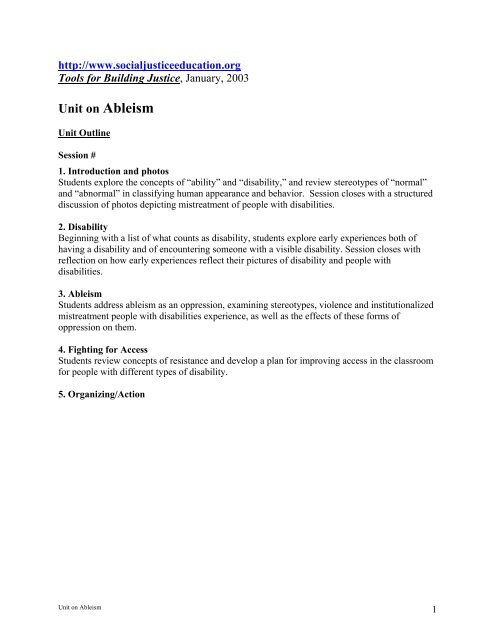
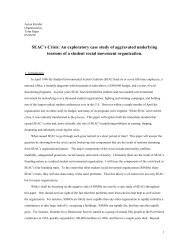

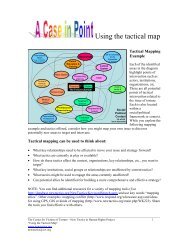
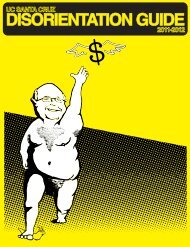

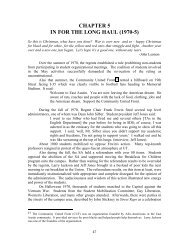
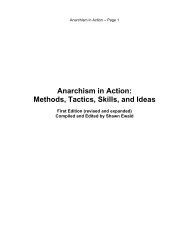

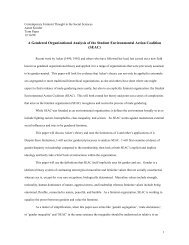


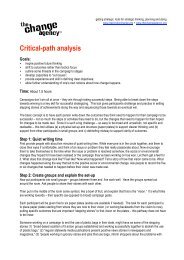

![Meaningful Student Involvement Research Guide [pdf] - SoundOut](https://img.yumpu.com/38822556/1/190x231/meaningful-student-involvement-research-guide-pdf-soundout.jpg?quality=85)